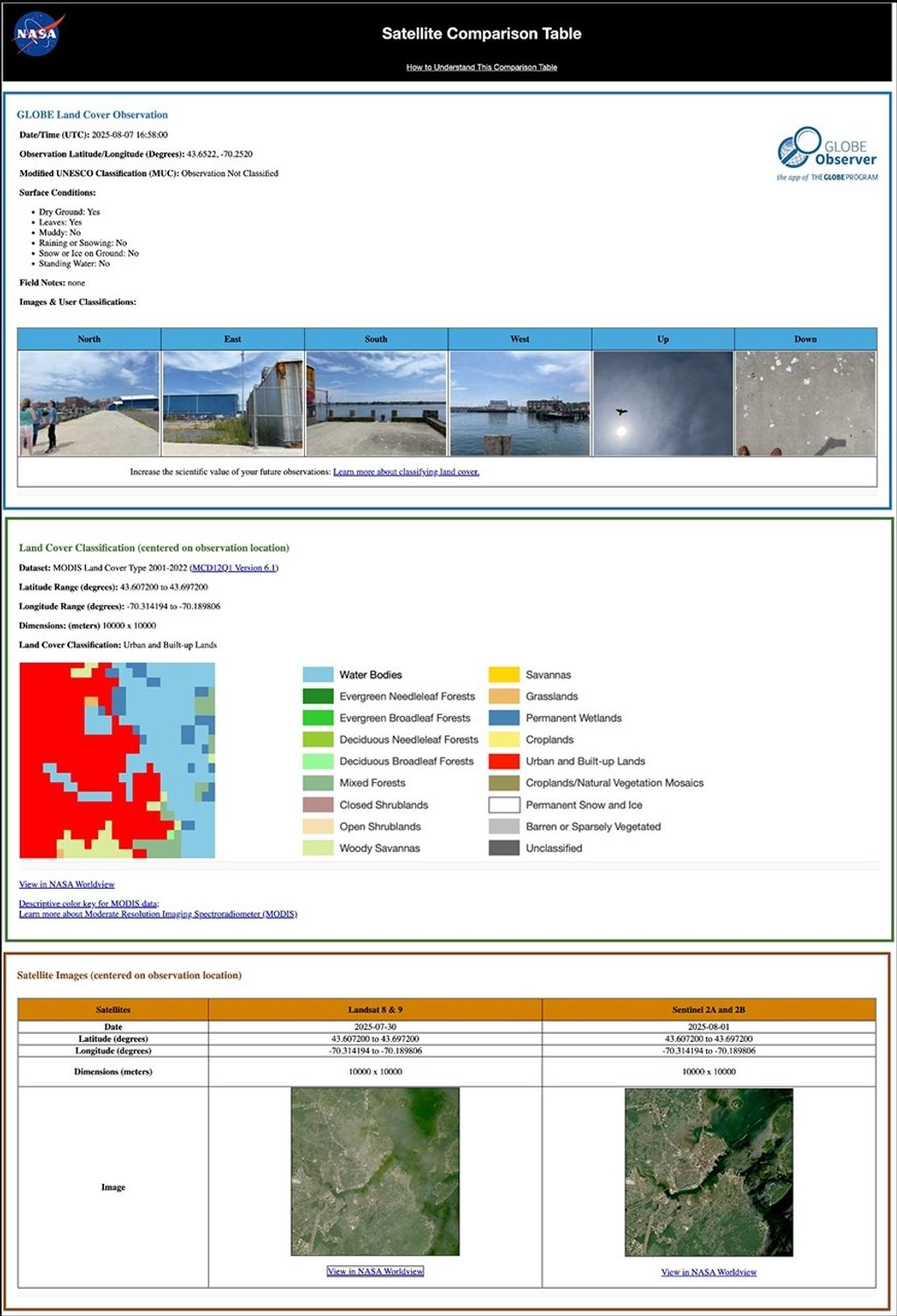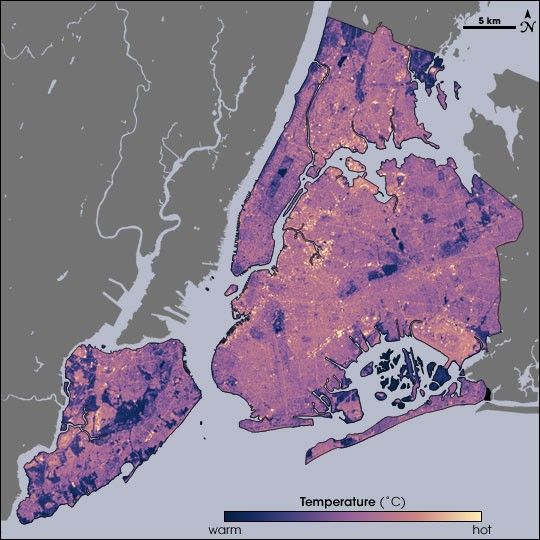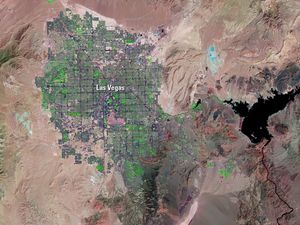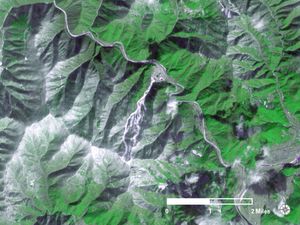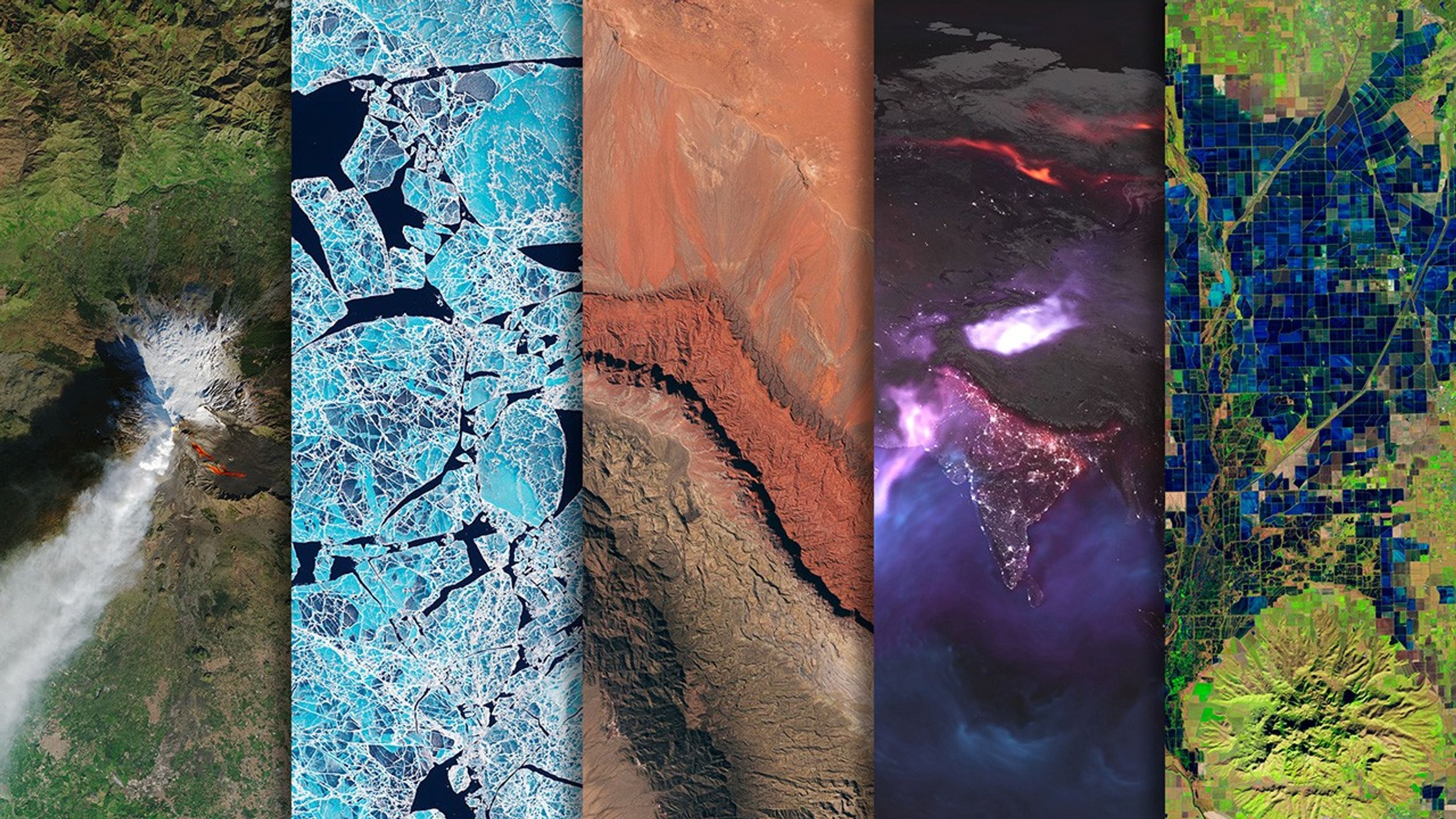When it comes to heat waves, Stuart Gaffin considers himself pretty lucky. An associate research scientist with the Earth Institute at Columbia University, Gaffin frequently studies heat waves. So far, however, he has managed to avoid getting caught in a deadly one, such as the Chicago heat wave of 1995, or the Paris heat wave of 2003. He lives in New York City, and the worst heat wave he remembers struck when he was in a nearby rural area. “We had no air conditioning, and it was so bad, it was like 106 degrees Fahrenheit,” he recalls. He left the countryside and rushed back to the city where his air-conditioned apartment awaited.
He admits the move was a little ironic.
Ironic because Gaffin also studies what’s known as the urban heat island—the tendency of cities to experience warmer temperatures than surrounding rural and suburban areas. In leaving the countryside, he actually headed for a hotter environment. Gaffin’s New York City apartment has air conditioning, but “we have a lot of poor communities in New York with low air conditioning rates,” he says. And electricity blackouts caused by a surge in demand during heat waves can catch anyone. “The heat wave problem is a real one, and one of the primary reasons to look at urban heat islands,” he explains.
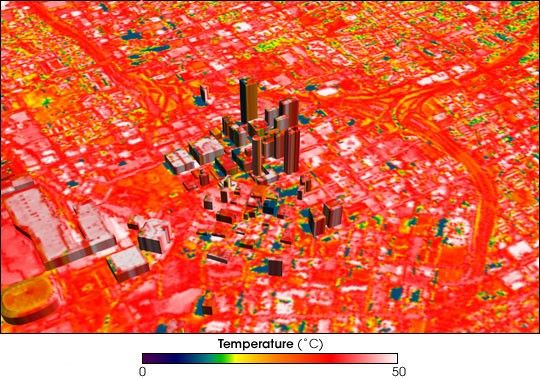
Two trends cause Gaffin to think seriously about urban heat islands. One trend is an increase in the number of city dwellers. “About half the world’s population—3 billion people—now live in cities. In a couple decades, it’s going to be 5 billion people,” he says. In developing countries, people often migrate to cities because of crop failures, natural disasters, or armed conflicts, not because cities have robust economies capable of supporting more people. In the coming decades, many new city dwellers will be desperately poor. With little access to air conditioning, refrigeration, or medical care, the world’s urban poor will be particularly vulnerable to heat wave health hazards.
The other trend that concerns Gaffin is climate change. He is no skeptic about global warming; he accepts the scientific community’s findings that Earth is heating up, pushed in part by human activity. But even if countries can reduce their greenhouse gas emissions, Gaffin suspects a certain amount of further warming is inevitable. “I think mitigating global warming is important,” he says, “but even with mitigation, all these people living in cities are going to experience some warming.” Based on research he conducted for the U.S. Global Change Research Program, he expects a warmer climate to worsen heat waves. “Right now, we average about 14 days each summer above 90 degrees [in New York]. In a couple decades, we could be experiencing 30 days or more,” he says.
“So we have two forces—urban heat islands and global warming—that are reinforcing each other and are going to create hot, hot conditions for more than half the world’s population,” Gaffin explains. “How do we make cities more habitable in the future?”
In 2002, Gaffin and several colleagues set out to answer that question for the United States’ most populated city: New York. To help urban planners figure out how to make city heat more bearable, Gaffin and his colleagues first had to consider how urban areas heat up their environments.
The Making (and Breaking) of an Urban Heat Island
On a hot, sunny afternoon, walk outside and find a parking lot bordered by grass. Put one hand on the asphalt and the other on the grass. The same surfaces of asphalt, stone, brick, and cement that keep weeds and water out of our way can sizzle in the sunlight and raise local temperatures. To make room for all these buildings and roads, cities squeeze out vegetation that would otherwise cool its surroundings by evaporating water. Added to the mix are car motors, hot air from air conditioners and clothes dryers, earth-moving machines, even smokestacks. All of these heat sources work together to raise temperatures. According to the U.S. Environmental Protection Agency, an urban area can see air temperatures up to 6 degrees Celsius (10 degrees Fahrenheit) hotter than the nearby suburban and rural areas.
New York City has produced its own urban heat island for more than a century. In the summer of 2002, Gaffin and his colleagues used satellite temperature data, city-wide land cover maps, and weather data, along with a regional climate model to identify the best strategies for cooling the city. The team estimated how much cooling the city could achieve by planting trees, replacing dark surfaces with lighter ones, and installing vegetation-covered “green roofs.”
The team studied the city as a whole, as well as six “hotspot” areas—including parts of Manhattan, the Bronx, Queens, and Brooklyn—where air temperatures near the ground were higher than the city-wide average. Each area was serviced by Con Edison, the local power company, so the scientists could compare electricity use. Each area also had available space so that the mitigation strategies the team considered could be modeled in the study and potentially implemented later on.

The urban heat island effect is perhaps most dangerous during heat waves, when demand for air conditioning soars, so the team concentrated on collecting data during those periods. Though heat wave definitions vary, for the 2002 study, the team settled on at least three consecutive days with maximum temperatures above 32.2 degrees Celsius (90 degrees Fahrenheit) in Central Park. Using National Weather Service data, the researchers identified three heat waves that summer: July 2–July 4, July 28–August 7, and August 11–August 18.
August 14 fell on one of the hottest heat wave days in New York’s summer of 2002, making it a good day to take the city’s temperature. Measuring the temperature of every last sidewalk, street, parking lot, roof, garden, and grassy area in an entire city isn’t easily done from the ground, so the researchers relied on NASA to take the city’s temperature from the sky. NASA’s Landsat Enhanced Thematic Mapper collected thermal infrared satellite data. At a spatial resolution (level of detail) of 60 meters per data pixel, Landsat offered detailed mapping of New York City’s urban heat island, supplementing temperature data the team used from the National Weather Service.
After collecting temperature measurements, Gaffin and his colleagues combined those measurements with other data, including a database of New York City land cover. Specifically, the team looked at how much of the city—and each smaller area under study—consisted of impervious surfaces and rooftops, grassy areas, trees, and water. The researchers then fed these data into a climate model. Developed by Pennsylvania State University and the National Center for Atmospheric Research, this model, known as MM5, predicts regional atmospheric circulation and weather phenomena.
Gaffin and his colleagues tested the model results against observed temperature and weather conditions in New York City to ensure its predictions were accurate. Then they ran the model assuming different conditions, such as a conversion of all of the city’s available roof area to light-reflecting surfaces. The model predicted that a combination of urban forestry and light roofs could reduce New York City’s overall temperature by 0.67 degrees Celsius (1.2 degrees Fahrenheit) throughout the day. At 3 p.m., when temperatures typically peak, these mitigation strategies could reduce New York City’s temperature by 0.89 degrees Celsius (1.6 degrees Fahrenheit). Results varied for the smaller areas under study, but Mid-Manhattan West realized the greatest temperature alleviation throughout the day, at -0.94 degrees Celsius (-1.7 degrees Fahrenheit), and Lower Manhattan East saw the best reduction at 3 p.m., at -1.33 degrees Celsius (-2.4 degrees Fahrenheit).
These temperature reductions might not sound like much, but they can actually have a big impact. Power usage, Gaffin explains, is very sensitive to even slight variations in temperature. “If you’re near the maximum power availability of your grid, which is often the case in these summer heat waves, each degree can make a significant difference in overloading the grid and leading to a blackout,” he says. So anything that would cool the city off, even a little, could ease energy demands and reduce blackout risks.
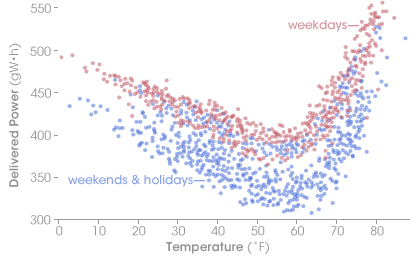
Gaffin found the modeling useful, although he harbors some reservations. “A lot of [regional climate] models were originally designed for natural land surfaces,” he explains. For cities, “we’ve got to take into account the thousands and hundreds of thousands of building geometries. The jury’s still out on how well we know what the temperature reductions will be.” The 2002 study provided enough evidence, however, to allow Gaffin and his colleagues to make some recommendations for mitigating the heat.
An especially effective mitigation strategy involved planting trees. Each tree could not only cool its immediate area, it could also cast shade onto nearby buildings. Gaffin and his colleagues estimated that 17 percent of the city’s surface could be planted with trees. They also estimated, however, that the biggest temperature reductions could be achieved by addressing New York City’s dark, impervious surfaces such as roads and roofs. Their assessment of the city indicated that 64 percent of the city area consisted of such surfaces.
About 14 percent of the New York City’s impervious surface area consists of rooftops, most of them dark, heat-generating surfaces, typically tar, and sometimes overlain with gravel. “The tar beach roof—ubiquitous in cities—is an oven in the summer, reaching 160 degrees Fahrenheit,” Gaffin explains. “So cooling off this roof is like turning off an open oven.” By turning off the open ovens that covered part of the city, New York could cool itself considerably. Two options exist for changing a tar beach roof into something cooler: a light-reflecting surface and vegetation.
Whites Versus Greens
Anyone who has ever planned to spend hours outside on a hot, sunny day has probably heard the advice to wear light colors. Pale colors reflect much of the Sun’s light, keeping their wearers cool. The same is true for buildings. Gaffin and his colleagues presented the results of their 2002 New York City heat wave study at a science meeting in January 2006, and at that time, he considered white roofs the winning strategy. By April 2006, however, he had changed his mind.
The study in New York confirmed that white roofs—generally made with the use of a thin, light coating—absorb much less of the Sun’s energy than asphalt roofs, and they are fairly inexpensive and easy to install. But even though white surfaces may be cooler than dark surfaces, they still trap heat. “Just go around your neighborhood. I think you’ll find that lighter urban surfaces are still pretty hot in the summer, compared to plants,” Gaffin says. What’s worse, “in urban settings, white roofs get dirty quickly,” reducing their ability to reflect sunlight. Even when they’re kept clean, white roofs cause problems, he explains. In reflecting the sunlight, they may just bounce much of it off nearby buildings, heating up the immediate area. “You haven’t really gotten the light out of the city,” he says. And in the wintertime, light roofs may cool buildings unnecessarily, increasing heating demands.
Light-colored roofs held another drawback for Gaffin. As he researched mitigation options for the urban heat island, he became aware of another issue that causes some cities as much hardship: stormwater runoff. “The purpose of asphalt is to create an impervious surface,” he explains, to keep out water. Unfortunately, the water that can’t be absorbed by roofs and roads has to go somewhere else.
To deal with runoff from heavy rains, cities have storm sewers, but many cities use the same systems to handle both the overflow from rainstorms and the water flushed out of toilets. Heavy rains can overwhelm these systems (called combined sewer overflows), pushing raw sewage into waterways. “It’s the major source of pathogens in the New York Harbor. It’s a major problem in Europe. This is one of the impediments to ever reclaiming the recreational and other values of our urban water systems,” he says. He has coined a term for this problem, as a parallel to the urban heat island. He calls it “the urban runoff island.” Light-colored roofs might absorb less of the Sun’s energy than dark roofs, he says, but they do nothing to mitigate runoff.
“I’m no fan of white roofs anymore,” Gaffin concludes. “I started this line of research thinking they should be promoted. I finished this research thinking they are a secondary option.”
Gaffin would rather promote a solution that addresses both urban heat and urban runoff. If cities don’t have much room for lots of additional trees, and if light-colored roofs only partially reduce urban heat and in no way reduce runoff, just one option remains: vegetation-covered roofs.
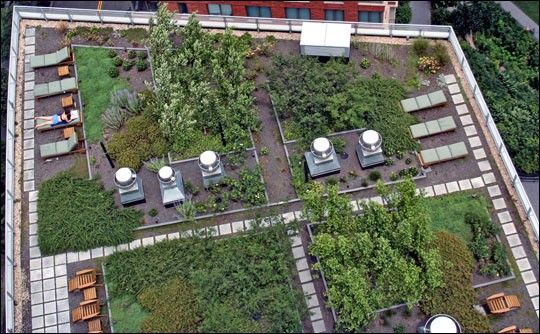
While Gaffin and his colleagues undertook the 2002 New York City study, experiments were already underway at Pennsylvania State University to assess the cooling capabilities of roofs covered with vegetation. In 2003, Gaffin worked with Penn State researchers to compare the temperatures of roofs planted with Sedum spurium to standard dark roofs.
“Sedum is a desert-adapted plant with shallow root systems. The plants can tolerate long periods of drought. They’re lush green, beautiful to look at, quite pleasant to touch,” he says. In the arid American Southwest, this cactus-family succulent is a popular landscaping choice for those looking to minimize water use in lawns.

During their rooftop garden project, Gaffin and the Penn State team found that the peak temperatures on the roofs planted with Sedum were 30 degrees Celsius (54 degrees Fahrenheit) lower than the temperatures on standard roofs. They also found that the low-maintenance Sedum plants thrived without any supplemental watering.

Despite Gaffin’s confidence in green roofs, he knows their implementation could be complicated. “A lot of people think green roofs are going to cause problems, that they’re going to leak or fall apart,” he says, “but it’s just the opposite. They actually leak less. There are [green] roofs in Europe that last 30, 40, 50 years, or more.” Longevity, however, comes at a price. “We spend a lot of time on the economics of green roofs. They’re expensive, and we’re trying to see how to bring the costs down. Part of the problem is that we don’t have a mature industry here in the United States. It’s still a somewhat specialized construction procedure.”
Vegetation-covered roofs typically include the following layers: a waterproof membrane at the bottom, a layer of drainage materials, a root-repellant and filter layer, a lightweight soil-like growing medium, and finally the plants. Compared to standard roofs, green roofs do have more mass, but thin systems of only 3 to 4 inches (7.5 to 10 centimeters) are sufficient. When they are saturated with rainwater, they may create a load of 1,197 pascals (about 25 pounds per square foot), which is often feasible for many city buildings. By evaporating moisture, the plants release heat without raising local temperatures. Likewise, the plants and soil soak up rainfall like a sponge instead of letting it roll right off the surface.

If green roofs do provide a sound solution to urban heat and runoff islands, they may need to be implemented differently in different places. The experiments in Pennsylvania showed that Sedum could thrive without irrigation, but Pennsylvania is more humid and rainy than other parts of the world. Places like sub-Saharan Africa and northwestern China are vulnerable to severe, prolonged droughts. Even gardeners in the American Southwest run into difficulties.
Horticulturalist Panayoti Kelaidis is the director of outreach for Denver Botanic Gardens. Like Gaffin, he admires the green roof concept and the drought-tolerant succulent Sedum. But Kelaidis doubts green roofs could succeed in an arid climate without supplemental watering. Switching to less thirsty plants wouldn’t necessarily solve the problem. “Some plants take even less water than Sedum. Some plants grow in saltpans. They could practically grow on the surface of the Moon,” Kelaidis says. Such plants respond to protracted dry spells, however, by going dormant. “The downside is that their biotic activity is so minimal when they are dormant, they’re no better than asphalt.” That doesn’t mean he thinks green roofs are doomed to failure, but he does think irrigation systems would be required. “Even modest irrigation would work. Just a mist of water would be enough.”
So in the driest climates, the ideal green roof might require an irrigation system, and overcoming the expense of implementing green roofs may slow their adoption. But as temperatures rise, the green roofs’ potential to cool cities remains attractive.
Recent heat wave tolls show the gravity of warming temperatures. The Chicago heat wave of 1995 claimed more than 700 lives. The record-warm European summer of 2003 claimed between 22,000 and 45,000 lives. “Can we air condition our way out of these heat waves? Not always,” Gaffin says. “So how can we cool these cities down? There aren’t many strategies we can choose. But green roofing looks like a great way to alleviate these problems.”
References
- Gaffin, S., Rosenzweig, C., Parshall, L., Beattie, D., Berghage, R., O’Keefe, G., and Braman, D. (2005) Energy balance modeling applied to a comparison of white and green roof cooling efficiency. Presentation at Greening Rooftops for Sustainable Communities, Third Annual International Conference, May 6, 2005, Washington, D.C.
- Gaffin, S., Rosenzweig, C., Parshall, L., Eichenbaum-Pikser, J., Greenbaum, A., Blake, R., Beattie, D., Berghage, R. (2006) Quantifying evaporative cooling from green roofs and comparison to other land surfaces. Presentation at Boston Green Roof Annual Conference, May 11, 2006, Boston, Massachusetts.
- Marshall, J. (2005) Megacity, mega mess. Nature. 437: 312-314.
- Meehl, G.A., and Tebaldi, C. (2004) More intense, more frequent, and longer lasting heat waves in the 21st century. Science. 305:994-997.
- Patz, J.A., Campbell-Lendrum, D., Holloway, T., and Foley, J.A. (2005) Impact of regional climate change on human health. Nature. 438: 310-317.
- Rosenzweig, C., Solecki, W., Parshall, L., Gaffin, S., Lynn, B., Goldberg, R., Cox, J., and Hodges, S. (2006) Mitigating New York City’s heat island with urban forestry, living roofs, and light surfaces. (PDF document, 108 KB) Presentation at 86th American Meteorological Society Annual Meeting, January 31, 2006, Atlanta, Georgia.
- Rosenzweig, C., and Solecki, W.D. (Eds.) (2001) Climate Change and a Global City: The Potential Consequences of Climate Variability and Change – Metro East Coast, Report for the U.S. Global Change Research Program, National Assessment of the Potential Consequences of Climate Variability and Change for the United States. Columbia Earth Institute, New York.
- Keeping New York City “cool” is the job of NASA’s “heat seekers” (2006) from NASA Goddard Institute for Space Studies. Accessed July 31, 2006.
- Metro East Coast Assessment (2001) from Center for Climate Systems Research Climate Impacts Group. Accessed July 31, 2006.
- The challenges facing an urban world from the BBC. Accessed June 20, 2006.
- Report reveals global slum crisis from the BBC. Accessed June 20, 2006.
- Heat island effect from the U.S. Environmental Protection Agency. Accessed June 20, 2006.
- MM5 Community Model from the National Center for Atmospheric Research and the UCAR Office of Programs. Accessed June 22, 2006.
- Green roofs from Pennsylvania State University. Accessed July 3, 2006.
- Earth Pledge. Accessed July 31, 2006.
NASA Earth Observatory story by Michon Scott; design by Robert Simmon and Michon Scott















